Another iconographic phenomenon, which we can learn from Wilkinson,
is the perspective relating water to the horizon:

The horizon, where the sea and the sky were joined together, was far away and
for the eye it appeared to be higher up than where the observer was standing.
This idea we can find also in the vocabulary of the Polynesians:
Eke. To climb, to mount, to mount (a female for
copulating), to surface (of fish), and by extension, to bite;
he eke te kahi the tuna bites. Vanaga. Trestle, stilt; to
mount a horse, to go aboard. Hakaeke, to cause to mount,
to carry on a boat. P Pau.: fakaeke, to transport, to
carry, to hang up. Mgv.: eke, to embark, to mount upon an
elevation. Mq.: eke, to rise, to go aboard; hakaeke,
to heap up, to put upon, to raise. Ta.: ee, to mount, to
go aboard; faaee, to hang up, to transport by water.
Churchill.
Iri. 1. To go up; to go in a boat on the sea (the surface
of which gives the impression of going up from the coast):
he-eke te tagata ki ruga ki te vaka, he-iri ki te Hakakaiga,
the men boarded the boat and went up to Hakakainga. 2.
Ka-iri ki puku toiri ka toiri. Obscure expression of an
ancient curse. Vanaga. Iri-are, a seaweed. Vanaga.
Moreover, in Egyptian art a distance far away was not depicted,
Wilkinson says, by decreasingly small figures but by 'heaping
up'
horizontal elements. This concept was evidently used when building
pyramids (heaps of stones):
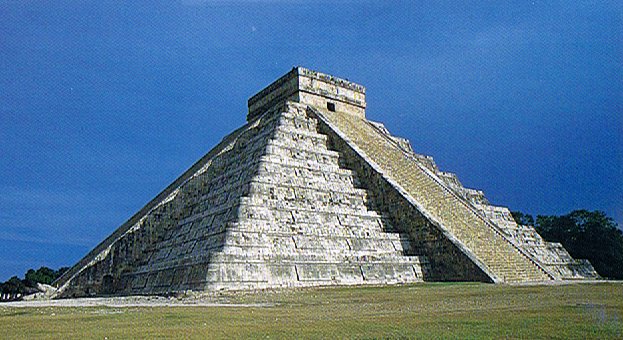
... I walked towards it now, and spent some
time strolling around it and clambering over it. Originally it
had been a clean-sided step-pyramid of earth faced with large
andesite blocks. In the centuries since the conquest, however,
it had been used as a quarry by builders from as far away as La
Paz, with the result that only about ten per cent of its superb
facing blocks now remained. What
clues, what evidence, had those nameless thieves carried off
with them?
As I climbed up the broken sides and around the deep
grassy troughs in the top of the Akapana, I realized that
the true function of the pyramid was probably never going to be
understood. All that was certain was that it had not been merely
decorative or ceremonial. On the contrary, it seemed almost as
though it might have functioned as some kind of arcane 'device'
or machine. Deep within its bowels, archaeologists had
discovered a complex network of zigzagging stone channels, lined
with fine ashlars. These had been meticulously angled and
jointed (to a tolerance of one-fiftieth of an inch), and had
served to sluice water down from a large reservoir at the top of
the structure, through a series of descending levels, to a moat
that encircled the entire site, washing against the pyramid's
base on its southern side ...
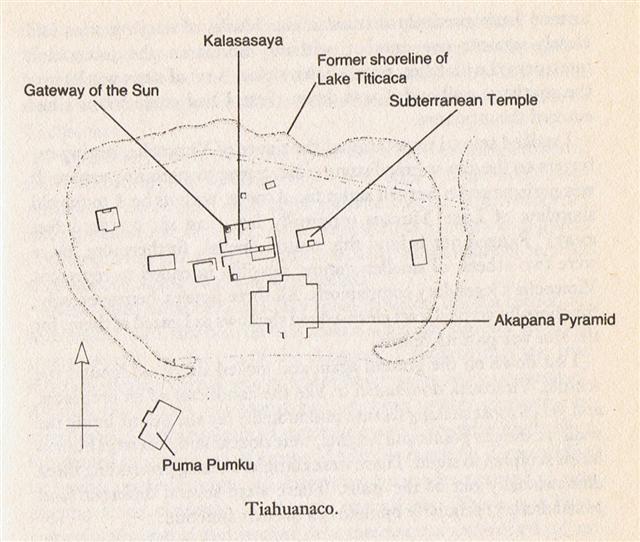
... The Euripus, which has already come up in
the Phaedo, was really a channel between Euboea and the
mainland, in which the conflict of the tides reverses the
current as much as seven times a day, with ensuing dangerous
eddies - actually a case of standing waves rather than a true
whirl.
We meet the name again at a rather unexpected
place, in the Roman circus or hippodrome, as we know from J.
Laurentius Lydus (De Mensibus I.12), who states that the
center of the circus was called Euripos; that in the middle of
the stadium was a pyramid, belonging to the Sun; that by the
Sun's pyramid were three altars, of Saturn, Jupiter, Mars, and
below the pyramid, altars of Venus, Mercury, and the Moon, and
that there were not more than seven circuits (kykloi)
around the pyramid, because the planets were only seven. (See
also F. M. Cornford's chapter on the
origin of the Olympic games in J. Harrison's Themis
(1962), p. 228; G. Higgins' Anacalypsis (1927), vol. 2.,
pp. 372ff.)
This brings to mind (although not called
Euripus, obviously, but 'the god's place of skulls') the Central
American Ball Court which had a round hole in its center, termed
by Tezozomoc 'the enigmatic significance of the ball court', and
from this hole a lake spread out before Uitzilopochtli was born.
See W. Krickeberg, 'Der mittelamerikanische
Ballspielplatz und seine religiöse Symoblik', Paideuma 3 (1948),
pp. 135ff., 155, 162.
And here the unstable Euripus of the Ocean,
which flows back to the beginnings of its mysterious source,
dragged with irresistible force the unhappy sailors, thinking by
now only of death, towards Chaos. This is said to be the maw of
the abyss, that unknown depth in which, it is understood, the
ebb and flow of the whole sea is absorbed and then thrown up
again, which is the cause of the tides. This is reflection of
what had been a popular idea of antiquity.
But here comes a version of the same story in
North America. It concerns the canoe adventures of two Cherokees
at the mouth of Suck Creek. One of them was seized by a fish,
and never seen again. The other was taken round and round to the
very lowest center of the whirlpool, when another circle caught
him and bore him outward. He told afterwards that when he
reached the narrowest circle of the maelstroem the water seemed
to open below and he could look down as through the roof beam of
a house, and there on the bottom of the river he had seen a
great company, who looked up and beckoned to him to join them,
but as they put up their hands to seize him the swift current
caught him and took him out of their reach. It is almost as if
the Cherokees have retained a better memory, when they talk of
foreign regions, inhabited by 'a great company' - which might
equally well be the dead, or giants with their dogs - there,
where in 'the narrowest circle of the maelstroem the water
seemed to open below' ...
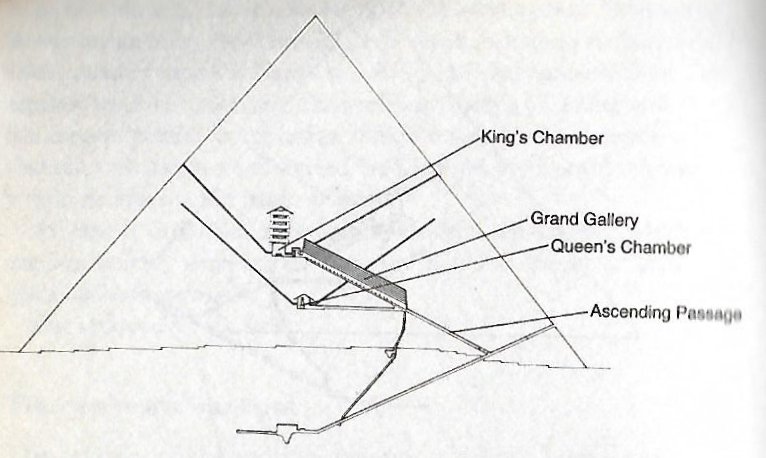
... The star [Thuban] could be seen, both by
day and night, from the bottom of the central passage of the
Great Pyramid of Cheops (Knum Khufu) at Ghizeh, in 30º of north
latitude, as also from the similar points in five other like
structures ...
... For some
reason, too, it had taken their fancy to place the Great Pyramid
almost exactly on the 30th parallel at latitude 29º 58' 51".
This, a former astronomer royal of Scotland once observed, was
'a sensible defalcation from 30º', but not necessarily in error:
For if the original designer had wished that
men should see with their body, rather than their mental eyes,
the pole of the sky from the foot of the Great Pyramid, at an
altitude before them of 30º, he would have had to take account
of the refraction of the atmosphere, and that would have
necessitated the building standing not at 30º but at 29º 58' 22'
...
... It is well known that the Khufu pyramid
was built in order to represent the northern hemisphere and
similarly was the pyramid of the Winged Serpent constructed to
visualize the year in the north ...
We have now aquired a basic understanding for why it was necessary to
use several waves. Eaha te ngaru?
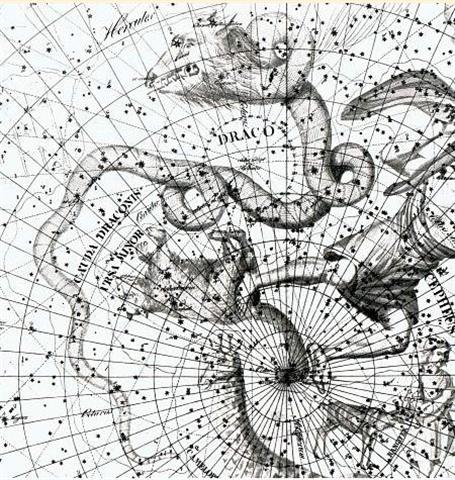
Because the goal was sitting high up on a flat rock, on a 'fragment of earth'
(where a secret was located):
... Up there on the flat rock [i
runga i te papa]. Furthermore, (there is the secret of
the) land. Seven (lands) remain in the midst of dim twilight
during the fast voyage. Not even eight groups of people (i.e.,
countless boat crews) can find anything. Only one thing can be
found, that is the fragment of earth (te pito o te kainga),
an eighth land.'
... Again Uure asked Ira [he ui
hokoou a Uure.kia Ira] 'Where is it on the rock?' Ira
replied to Uure, 'Up on the flat rock of Hangaroa.' Again Uure
spoke [he ki hokoou mai a Uure]
'Is it on the flat rock itself?' Ira replied [he
ki mai a Ira], 'To find it, one has to ride the waves
...
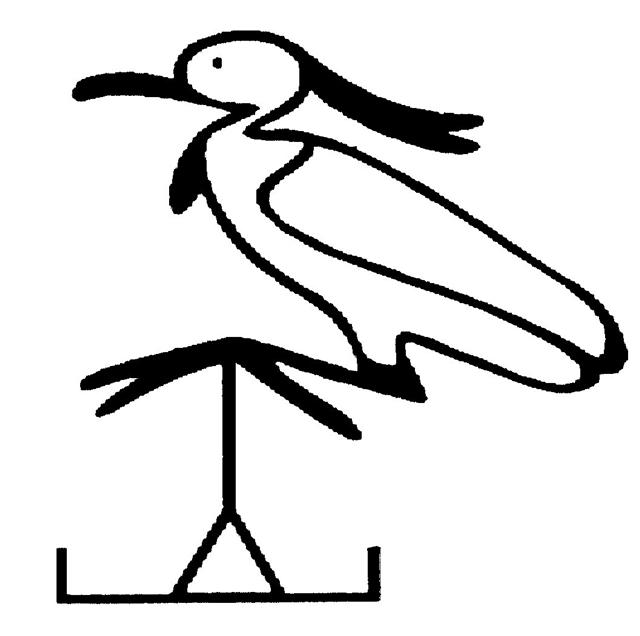
... True pyramids
(at least the larger ones) as opposed to step pyramids, in Egypt
were topped by a special stone called a pyramidion,
or sometimes a capstone, which was itself a miniature pyramid.
It brought the pyramid structure to a point at the same angle
and the same proportions as the main body. Actually, the ancient
Egyptian word for the pyramidion, which could also sit atop the
apex of an obelisk, was ben-benet,
named for the sacred ben-ben stone kept in the temple of
Heliopolis, the oldest center of the sun cult in Egypt. During
the Old Kingdom, they were usually made of diorite, granite or a
very fine limestone which was then covered in gold or electrum.
By the Middle Kingdom and the end of the Pyramid Age, they were
usually made of granite and inscribed with texts and symbols ...
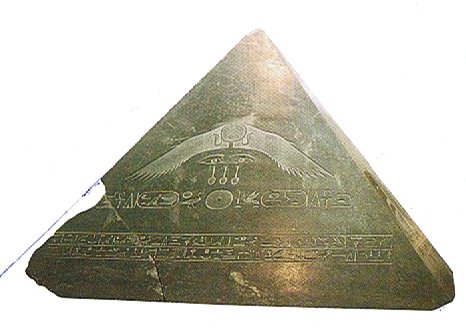
There were 3 beautiful waves (vave
renga):
|
a te rara mata'u |
to the right side (towards) |
te rei i a ruhi |
the ornament of Ruhi |
| |
|
a te rapa mai |
from where the shine comes (towards) |
te rei o pu |
the ornament of Pu |
| |
|
a te tini |
to the middle (towards) |
te tuitui reipa |
the mother-of-pearl necklace |
Vave. Water in
motion, a long wave; pokopoko vave, trough of the sea;
tai vave, rough sea; vave kai kohe, unapproachable.
Churchill. Pau.: A fringing reef. Mgv.: taivave, a
rolling billow. Ta.: vavea, a towering billow. Churchill.
Rega. Ancient word,
apparently meaning 'pretty, beautiful'. It seems to have been
used also to mean 'girl' judging from the nicknames given young
women: rega hopu-hopu. girl fond of bathing; rega
maruaki, hungry girl; rega úraúra, crimson-faced
girl. Vanaga. Pau.: rega, ginger. Mgv.: rega,
turmeric. Ta.: rea, id. Mq.: ena, id. Sa.: lega,
id. Ma.: renga, pollen of bulrushes. Churchill.
Rapa. 1. To shine;
shiny, polished; he-rapa te moai miro, the wooden
figurine is shiny, polished. 2. Emblem, badge of timo îka
(person entrusted with putting a death spell on an assassin).
Rapahago, name of a spirit (akuaku), anciently
considered as benevolent; rapahago, a fish. Raparapa,
to dazzle; dazzled: he-raparapa te mata. Marîa
raparapa, calm, smooth shiny sea. Vanaga. 1. Pau.: rapa,
a fool, madness. Ma.: rapa, a familiar spirit. 2. Pau.:
rapa, blade of a paddle. Mgv.: raparapahoe, id.
Ta.: rapa, id. Mq.: apa, id. Sa.: lapa,
flat. Ma.: rapa, flat part of a shovel. 3. Pau.: rapae,
a sand-pit. Ta.: rape, arapai, id. 4. Mgv.:
rapahou, primipara. Ma.: rapoi, id. 5. Mgv.:
raparapa, green. Ta.: rapa, id. 6. Mgv.: raparapa,
flat. Ta.: rapa, a flat rock. Sa.: lapalapa, a
flat coral. Ma.: raparapa, the flat part of the foot. 7.
Ta.: raparapa, square. To.: labalaba, id. Ha.:
lapalapa, square (of timber, of a bottle, of a cow yard).
Churchill.
Looking again at the ancient Babylonian map I guess it might be
possible to put in parallel its Horse with the first
wave, its Stag
with the second, and the fish Anunitum with the third (in
the middle):

According to the Hindu nakshatra structure we can find the
Head of the Horse separated from the Head of the Stag
by 8 weeks:
|
ARIES: |
|
1 |
Ashvini |
β and γ Arietis |
Horse's head |
April 17 (107) |
|
wife
of the Ashvins |
Sheratan and Mesarthim |
|
2 |
Bharani |
35, 39, and 41 Arietis |
Yoni, the female organ of reproduction |
May
1 (121) |
|
the
bearer |
Musca Borealis |
|
TAURUS: |
|
3 |
Krittikā |
M 45 Tauri |
Knife or spear |
May
15 (135) |
|
the nurses of Kārttikeya |
The
Pleiades |
|
4 |
Rohini |
α Tauri |
Cart
or chariot, temple, banyan tree |
May
28 (148) |
|
the
red one |
Aldebaran |
|
ORION: |
|
5 |
Mrigashīrsha |
λ, φ¹, and φ² Orionis |
Stag's head |
June
12 (163) |
|
the
deer's head |
Heka |
In the middle (te tini) between day 107 and day 163
was day 107 + 4 * 7 = 135, where the first half of the
Pleiades rose with the Sun - immediately after a triplet
of 'causative waves' (te ua):
|
te ua |
koia ra |
kua tuku ki to
mata - ki tona tukuga |
e kiore - henua -
pa rei |
|
Ua.
  
1. Cause, reason why something happens or
is done; he ûa te ua, au i-ta'e-iri-ai ki tooku
hare, because of the rain, I did not go home;
ua kore, without cause, without reason. 2.
Ceremononial stave with a human face carved at one
extremity. Vanaga. Cfr toko. 1. A long club
T. 2. Mgv.: ua, the genitalia. Ta.: hua,
id. Mq.: hua, id. Ha.: hua, testicles.
3. Ta.: ua, the back of the neck. Ma.: ua,
id. Sa.: ua, the neck. 4. Ta.: ua, a
land crab which shears iron. Ma.: uka,
lobster. Sa.: uga, the hermit crab.
Churchill. Ûa.
Rain; 1. ûa hakamito, persistent,
but not strong, rain; 2. ûa kura, fine rain,
drizzle; 3. ûa matavaravara, strong rain; 4.
ûa parera, torrential rain; 5. ûa tai,
rain followed by fair weather at sea. Ehu ûa,
drizzle. Vanaga.
Ûaûa. Tendons, muscles. 1. Hau ûaûa
kio'e, line made from rats' tendons. 2. Ûaûa
toto, vein, artery. 3. Ûaûa piki, spasm.
Vanaga. 1. Rain; hoa mai te ua, to rain;
mou te ua, to cease raining. P Mgv., Mq., Ta.:
ua, rain. 2. Vein, artery, tendon (huahua
1) (uha
G); ua nene,
pulse; ua nohototo,
artery, ua gaei,
pulse. Uaua,
vein, tendon, line;
kiko uaua, muscle T.
Hakauaua,
to mark with lines. P Pau.:
tare-ua,
tendon. Mgv., Mq., Ta.:
uaua, vein, tendon. Churchill.
U'a. Of the
tide, to reach its maximum; tai u'a, high
tide. Vanaga. Wave, surge; tai ua, high tide.
Churchill. Uá. Ata
uá, morning twilight.
Uáuá, to
reside; resident; noho uáuá to settle
somewhere; ina koe ekó noho uáuá, do not
establish yourself there. Vanaga.
Ko. 1. Article (ko te);
preposition: with (see grammar); prefix of
personal pronouns: koau, I; kokoe, you
(singular); koîa, he, she, it; kokorua,
you (plural); ko tagi, koîa, he with his
weeping. 2. Article which precedes proper nouns,
often also used with place names: Ko Tori, Ko
Hotu Matu'a, Ko Pú. Koîa, exact:
tita'a koîa, exact demarcation. Seems to be the
personal pronoun koîa - applied in the
meaning of: thus it is, here it is precisely.
Vanaga. 1. Negative; e ko, not, except; e
ko ora, incurable; ina ko, not; ina ko
tikea, unseen; ina e ko, not; ina e ko
mou, incessant. 2. A particle used before nouns
and pronouns; ko vau, I; ko te, this;
ko mea tera, this; ati ko peka, to
avenge, ko mua, first, at first, formerly. 3.
There, yonder. P Mgv.: ko, over there,
yonder. Ta.: ó, there, here. Churchill.
Ta.:
ra, a day.
Pa.
1. Mgv.: pa, an inclosure, a
fenced place. Ta.: pa, inclosure,
fortification. Mq.: pa, inclosure. Sa.: pa,
a wall. Ma.: pa, a fort. 2. Mgv.: pa,
to touch. Sa.: pa'i, id. Ma.: pa, id.
3. Mgv.: pa, to prattle. Ta.: hakapapa,
to recount. 4. Mq.: pa, a hook in bonito
fishing. Sa.: pa, a pearlshell fishhook. Ma.:
pa, a fishhook. Pau.: hakapa, to feel,
to touch. Mgv.: akapa, to feel, to touch, to
handle cautiously.
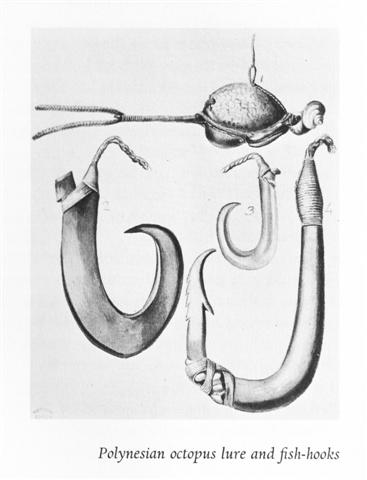
... Ana
Onoono is a cave well-suited as an overnight
shelter; Pu Ngotangota is a coastal formation where
the seawater is allowed to flow in and out. The
three additions, 'house', 'cave', and 'hole', always
describe an enclosed area ...
This statement of Barthel ought to
be extended to include also pa itself.
... In
later research it was postulated that the
[Phoenician] alphabet is actually two complete
lists, the first dealing with land agriculture and
activity, and the second dealing with water, sea and
fishing. The first half
beginning with Alef - an ox, and ending with
Lamed - a whip. The second list begins with
Mem - water, and continues with Nun -
fish, Samek - fish bones, Ayin - a
water spring, Peh - the mouth of a well,
Tsadi - to fish, Kof, Resh and
Shin are the hook hole, hook head and hook
teeth, known to exist from prehistoric times, and
the Tav is the mark used to count the fish
caught ... |
 |
 |
 |
 |
|
Cb2-4 (420 = 7 * 60) |
Cb2-5
(29) |
Cb2-6 |
Cb2-7 |
|
... The Maya word cab
means earth, world, tierra, the place below,

opposed to caan, the sky.
The overwhelming evidence on the glyph and its
associations in the pictures and texts is for this
same meaning, Earth. A most interesting glyph in
this connection is one found in Maudslay's Tikal,
plate 74, glyph 13, our form 17.33.
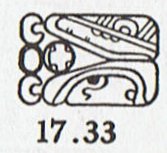
The text on the stela shows that
this glyph indicates the passage of one day, from
6 Eb, 0 Pop to 7 Eb, 1 Pop; the sun or
kin, preceded by the numeral 1, is seen entering
between the caban-sign and what we shall
later come to identify as the sky-glyph ...
In the
beginning there were only Sky and Earth 'in close
embrace', and when Air entered in between them it
was a fundamental change from 2 to 3.
... The ancient Chinese said:
One generates Two, Two generates Three, and Three
generates Everything.
And
reasonably there should be a Sign of '3' where this
event occurred. At left in glyph 17.33 a triplet of
'stones' arranged vertically could have visualized
the season of Sky (top), the season of Air
(central) and the season of Earth (bottom). But
since top and bottom are quite similar the meaning
could be the northern sky respectively the southern
sky with the equatorial (inhabitable) belt in
between ... |
|
CLOSE TO
THE SUN: |
|
Nov 13
κ
Librae (237.2),
ι
Serpentis (237.4),
ψ²
Lupi,
ρ
Oct.
(237.5), γ Cor. Borealis, η Librae (237.7),
COR
SERPENTIS = α Serpentis
(237.9)
*196.0 = *237.4 - *41.4 |
14
π
Cor. Borealis,
UNUK
ELHAIA (Necks of the Serpents) = λ Serpentis
(238.1),
CHOW =
β Serpentis
(238.6) |
15
κ
Serpentis (239.3),
δ
Cor. Borealis,
TIĀNRŪ
= μ Serpentis
(239.5),
χ
Lupi, (239.6),
ω
Serpentis (239.7),
BA (=
Pa) = ε Serpentis,
χ
Herculis (239.8).
κ
Cor.
Borealis, ρ Serpentis (239.9) |
16 (320)
λ
Librae (240.0),
β
Tr. Austr. (240.3),
κ
Tr. Austr. (240.4),
ρ
Scorpii (240.8)
*199.0 = *240.4 - *41.4 |
|
'Oct 17
(290) |
18 |
19 (292
= 4 * 73) |
20 |
|
"Oct 3 |
4 (277) |
5 |
6 |
|
SEPT 10 |
11 |
12 (255
= 3 * 85) |
13 |
|
DAY 237 |
238 |
239 |
240 |
|
CLOSE TO THE FULL
MOON: |
|
May 14
δ Persei (54.7) |
15 (500 = 365 + 135)
Al Thurayya-27 (Many Little Ones) /
Krittikā-3 (Nurses of Kārttikeya) /
TAU-ONO (Six Stones)
ATIKS
= ο Persei,
RANA
(Frog) = δ Eridani
(55.1),
CELAENO (16 Tauri), ELECTRA (17), TAYGETA (19),
ν
Persei (55.3),
MAIA
(20), ASTEROPE (21), MEROPE (23)
(55.6) |
16 (136)
Hairy Head-18 (Cockerel) /
Temennu-3 (Foundation Stone)
ALCYONE
(56.1),
PLEIONE
(28 Tauri),
ATLAS (27 Tauri)
(56.3) |
17
MENKHIB (Next to the Pleiades = ζ Persei
(57.6)
PORRIMA (γ Virginis) |
|
'April
17 (80 + 27) |
18 (108 = 135 - 27) |
19 |
20 |
|
BISSEXTUM (54 - 55) |
56 (8
WEEKS) |
57 (=
137 - 64 - 16) |
|
... The leap day was introduced as part of the
Julian reform. The day following the Terminalia
(February 23) was doubled, forming the 'bis
sextum - literally 'double sixth', since
February 24 was 'the sixth day before the Kalends of
March' using Roman inclusive counting (March 1 was
the 'first day'). Although exceptions exist, the
first day of the bis sextum (February 24) was
usually regarded as the intercalated or 'bissextile'
day since the third century. February 29 came to be
regarded as the leap day when the Roman system of
numbering days was replaced by sequential numbering
in the late Middle Ages ... |
|
"April 3
|
4 |
5 |
6 (96) |
|
MARCH 11 |
12 (135
- 64 = 71) |
13 |
14 (→ π) |
|
DAY 54 |
55 |
56 |
57 |
|
54 Vai Rapa |
- |
56 (Sic!) Vai
Rutu Manu |
57 Hanga Piko |
|
54 vai rapa
a hakaremereme |
56 te vai rutu manu a koro rupa.e
haho e hivi e
e runga e
te puku ohu kahi e. |
57 hanga
piko a hare rutu manu a
ana onoono
a Pu
ngotangota. |
|
According to Barthel the 'shimmering
water' (vai rapa) was located north of Ana
Kai Tangata (Cave for Eating Man) with Hanga
Piko (Curved Bay) a bit further north. In
between was Te Vai Rutu Manu:
... The
'watering place' where the bird beats (the rhythm)'
- wordplay, 'where a certain chant is being recited'
- is located near Hanga Piko. A recitation provides
the following information for the additional name:
'In Koro Rupa is the house where one is made to
laugh; in Kere Mea is the house where one is made
fun of' (Barthel 1960:851; Campbell 1971:400). There
the rule of the new birdman was celebrated (compare
koro 'feast'). In RAP., koro rupa
seems to have the same meaning as in TUA.
kororupo, which describes a paradise. In the
cosmology of the TUA., the name also referred to the
entrance to the underworld. Hivi (maybe the
same as hi ivi 'to fish with a hook made from
bone'; compare the narrative ME:363) is 'outside',
and 'the elevation from where (the catch of) the
tunafish is announced' is 'above'. This is a
reference to a large boulder beside the place where
the canoes docked in Hanga Piko. There the people
waited for the canoes to return from the fishing
grounds." (The Eighth Land, pp. 89-90.)
Kahi.
Tuna; two sorts: kahi aveave, kahi matamata.
Vanaga. Mgv.: kahi, to run, to flow. Mq.:
kahi, id. Churchill. Rangitokona, prop up
the heaven! // Rangitokona, prop up the
morning! // The pillar stands in the empty space.
The thought [memea] stands in the earth-world
- // Thought stands also in the sky. The kahi
stands in the earth-world - // Kahi stands
also in the sky. The pillar stands, the pillar - //
It ever stands, the pillar of the sky. (Morriori
creation myth according to Legends of the South
Seas.)
Puku. 1. To
feel an urge to defecate or to urinate, etc.:
ku-puku-á te mimi: to need to urinate. 2. Rock,
boulder: puku ma'ea; puku oone,
hillock, earth mound. 3. Puku tagata, pubis.
Puku-ine, to get stuck in the oesophagus (of
food). Pukupuku, joints, bones of a joint;
pukupuku rima, wrist bones; pukupuku va'e,
ankle. Pukuraga, followers, disciples,
students. Puku rekoreko is the juicy part
between two knots (puku). Vanaga. 1. Puku
haga oao, east, east wind. 2. Pubes. T Mgv.:
puku, clitoris; pukuhou, the age of
puberty; pukutea, a man between 30 and 45. 3.
Unripe; puku no, unripe; pukupuku,
green, immature. Mgv. puku, to be unripe.
Mq.: puku, a fruit which has not yet reached
its maturity. 4. To gorge; mahaga puku, to
take the bait greedily. PS Sa.: pu'u, to take
the whole at one mouthful, to put into the mouth
whole. Fu.: pukupuku, to rinse the mouth, to
gargle. Niuē:
puku, to take
into the mouth. Pukuhina,
(puku 4),
to choke on a fishbone. Pau.: pukua,
to choke with a fishbone. Mgv.: pukua,
to be suffocated by anything that sticks in the
throat. Mq.: pukua,
bad deglutition. Ta.: puunena,
puufeto,
to choke, to gag. Ha.: puua,
to be choked, to have something sticking in the
throat. Pukupuku;
1. Elbow. G. 2. Wrinkled, knotty, wen, scrofula;
gao pukupuku,
scrofula. T Pau.: puku,
a swelling; pukupuku,
a wrinkle, knotty, rough. Mgv.: puku,
a knot in the wood; pukupuku,
knotted, rough, uneven, lumpy. Mq.: puku,
knot in wood, boss, protuberance, tumor, boil;
toopuku, toopuu, boil, wart,
tumor;
pukupuku, wrinkled,
knotty. Ta.: puú,
boss, protuberance, swelling; puúnono,
tumour; puúpuú,
wrinkled, knotty. Pukuraga,
servant T. Churchill. Rei matapuku,
necklace made of coral or of mother-of-pearl. Henry.
Ohua. Night in
the Moon calendar:
 |
 |
 |
|
Ohua |
Otua |
|
CLOSE TO THE SUN: |
|
12h (182.6) |
ALCHITA |
PÁLIDA |
|
DAY 182 |
183 |
184 |
|
CLOSE TO THE FULL MOON: |
|
March 20 |
SIRRAH |
ALGENIB PEGASI |
|
DAY 364 |
0h (365.25) |
1 |
This 'bird beating the rhythm' was
mentioned also at the item for Hanga Piko, in
the house (hare) of the cave (ana)
'SixSix' (onoono).
"Ana
Onoono is a cave well-suited as an overnight
shelter; Pu Ngotangota is a coastal formation where
the seawater is allowed to flow in and out. The
three additions, 'house', 'cave', and 'hole', always
describe an enclosed area." (Barthel, a.a., p 90)
Clearly Ana Onoono may have
been referred to earlier in Manuscript E, when they
carried the severely injured Kuukuu down into
a cave and piled up 6 stone heaps outside who would
answer when he called out → 6 heaps for 6 men →
36(0).
Likewise can we perceive a
correspondence between the coastal formation Pu
Ngotango, where water freely flowed in and out,
and the movements of the explorers when they
'behaved like turtles', when they rode the waves
repeatedly towards the beach. 'Turtle' → boat (cfr
Zaurak).
...
po-tagotago, darkness. po o te tagata,
life ... |
|
... we read of a fisherman later revered as a deity
named Urashima: He was hadsome of feature ...
He went out alone in a boat to fish with hook and
line. During three days and nights he caught
nothing, but at length he caught a turtle of five
colours. Wondering, he put it in the boat ... While
he slept the turtle suddenly became transformed into
a woman, in form beautiful beyond description ... He
said to her, 'This place is far from the homes of
people, of whom there are few on the sea. How did
you so suddenly come here?' Smiling she replied, 'I
deemed you a man of parts alone on the sea, lacking
anyone with whom to converse, so I came here by wind
and cloud.'
She is, of course, a Kami [a spirit], as he
quickly understands, from a magical land that 'lasts
as long as sky and earth and ends with sun and
moon'. And she tempts him: 'You can come to that
region by a turn of your oar. Obey me and shut your
eyes.' So presently they came to a broad island in
the wide sea, which was covered with jewels. (On it
was a great mansion.) Its high gate and towers shone
with a brilliance which his eyes had never beheld
and his ears had never heard tell. They enter the
mansion and are received and greeted in a loving
fashion by her parents: 'Seated they conversed of
the difference between mankind and the
Land-of-Spirits, and the joy of man and Kami
meeting.
Eventually the fisherman Urashima and the
beautiful sea Kami are married. Thereafter:
'For three years, far from his aged parents, he
lived his life in the Spirit capital, when he began
to yearn for his home and for them.' Observing the
change in him, his wife asks: 'Do you desire to
return home?' He replies: 'To come to this far
Spirit Land, I parted from my near and kin. My
yearning I cannot help ... I wish to return to my
native place to see my parents for a while'. Then we
read: Hand in hand they walked conversing ... till
they came to where their ways diverged and where her
parents and relatives, sorrowing to part with him,
made their farewells.
The princess informed him that she was indeed the
turtle which he had taken in his boat, and she took
a jewel-casket and gave it to him saying: 'If you do
not forget me and desire to seek me, keep this
casket carefully, but do not open it.' Thus he
parted from her and entered his boat, shutting his
eyes as she bade him. In a trice Urashima
finds himself back in his home village again but a
terrible surprise awaits him. During the three years
that he has spent enchanted on the Spirit island 300
mortal years have passed and everything has changed
beyond recognition. Stumbling around dazed and
disconsolate, discovering from a passer-by that his
own disappearance three centuries previously is
itself now the subject of a village legend, he
forgets the warning about the jewel box and opens it
to remind himself of his Kami wife: 'But
before he could look into it, something in the form
of a blue-orchid soared up to the blue sky with the
wind and clouds. Then he knew that, having broken
his oath, he could not go back and see her again
... |
|
... Several Asian
cultures, including that of the Andaman Islands,
believe that humanity emerged from a bamboo stem. In
the Philippine creation myth, legend tells that the
first man and the first woman were split open from a
bamboo stem that emerged on an island created after
the battle of the elemental forces (Sky and Ocean).
In Malaysian
legends a similar story includes a man who dreams of
a beautiful woman while sleeping under a bamboo
plant; he wakes up and breaks the bamboo stem,
discovering the woman inside. The Japanese folktale
'Tale of the Bamboo Cutter' (Taketori Monogatari)
tells of a princess from the Moon emerging from a
shining bamboo section. Hawaiian bamboo ('ohe)
is a kinolau or body form of the Polynesian
creator god Kane.
An ancient
Vietnamese legend tells of a poor, young farmer who
fell in love with his landlord's beautiful daughter.
The farmer asked the landlord for his daughter's
hand in marriage, but the proud landlord would not
allow her to be bound in marriage to a poor farmer.
The landlord decided to foil the marriage with an
impossible deal; the farmer must bring him a 'bamboo
tree of one-hundred sections'. The benevolent god
Bụt appeared to the farmer and told him that
such a tree could be made from one-hundred sections
from several different trees. Bụt gave the
him four magic words to attach the many sections of
bamboo: 'Khắc nhập, khắc xuất', which means
'put in immediately, take out immediately'. The
triumphant farmer returned to the landlord and
demanded his daughter. The story ends with the happy
marriage of the farmer and the landlord's daughter
... |

... I am thus suggesting there was
an intended correspondence between
the missing number 55 in the
sequence of Makoi stations
and the first day of the Pleiades:
|
1 Ko Apina Iti |
27 |
29 Ko Te Rano A Raraku |
23 |
54 Vai Rapa |
(55) |
4 |
60 Apina Nui |
|
29 |
24 |
5 |
|
58 |
|















